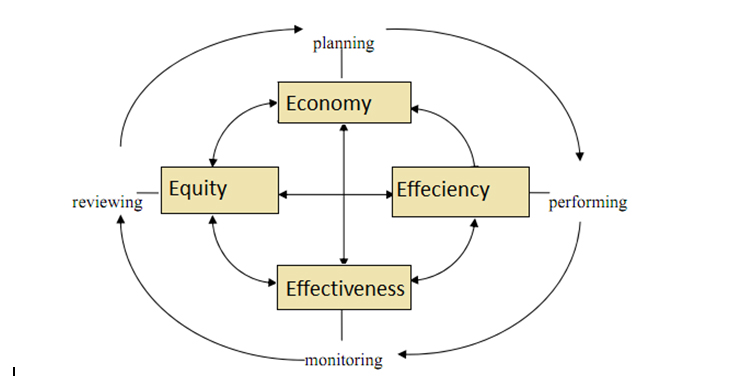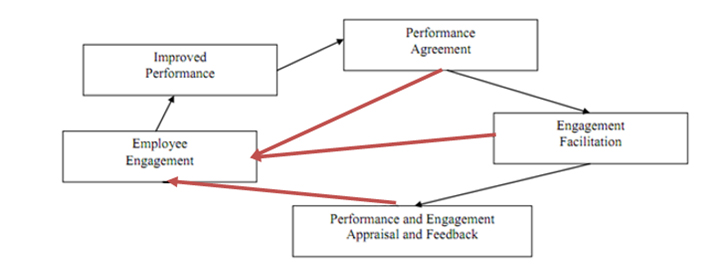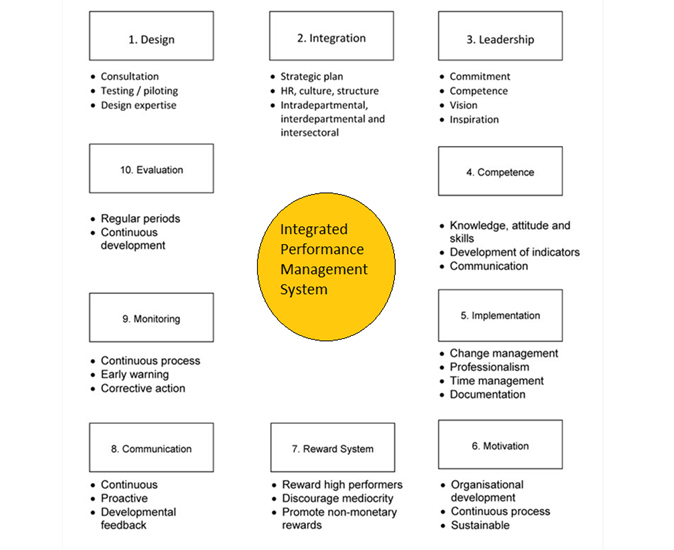Performance Management (Human Resource Management)
Performance management is one of the central processes of human resource management. It is an ongoing process of communication between a manager and an employee that occurs throughout the year in order to achieve the strategic objectives of the organization. A formal performance evaluation is an important opportunity to review the informal evaluations of the employee's performance over a longer period of time. Performance appraisal was documented for a means for enthusiasm and development in the United States in the decade of 1950 (Cardy & Dobbins 1994). Performance management is described as a systematic process which has aim to improve human performance within the organization (Warren, 1982). According to SHRM (the Society for Human Resource Management), "performance management is the organized method of monitoring results of work activities, collecting and evaluating performance to determine achievement of goals, and using performance information to make decisions, allocate resources and communicate whether objectives are met."
Performance management initially developed for the private enterprise sector, which comprises of the practical scheme and management techniques to boost employee performance in order to chase corporate performance. Some studies focus on appraising the past performance of the employee and the organization. Nonetheless, the original concept of performance management is to add the future performance of the employee and organization into the management structure, and further to discover various new management approaches to attain organizations' goals (Beer et al., 1978). Lunger (2006) stated that existing performance management must initiate from organizational development strategies, goals and values, the synchronization functions of performance, the satisfaction of internal and external customers, the focus on group and team performance, the importance of cross-sector and cross-function appraisal, the performance monitoring and development, the evolution of performance measurement with time and sustained growth. Another theorist, Armstrong designated that the application of performance management is to enhance the organization members' performance by developing the capability of the team and its members through a strategic and integrated system which can promote organizations to operate successfully.
Performance management cycle
Companies can envisage performance management as a cycle of constant improvement. The components of this cycle include the planning stage where organizations may involve in strategic planning processes, establish the objectives for their programs and make a vision of the future of their communities. In the executing stage, firms perform programs and services that line up with the strategic plan and help the organization to achieve its objectives and mission. Monitoring stage is useful because it measures positive changes in skills, attitudes or behaviours. The analysing and sharing stage helps non-profit organizations to make sense of the data that they are collecting. This stage lets non-profits organizations to learn what is going well, how they accomplish their objectives, and what other impacts are occurring in the community. The adapting stage occurs when organizations learn from the data and use it to build good programs that meet the organizational mission.
Though performance management enhances organizational output but some theorists are against this view. Pulakos and O'Leary argued that performance management systems are unsuccessful because they focus more on administrative processes (i.e., documentation) than on training managers and employees how to engage in effective performance management behaviours (e.g., communicating clear goals and expectations). Mone and London (2010) emphasize that if PM systems are designed to promote employee engagement, it may lead to higher levels of performance. Likewise, Gruman and Saks (2011) stated that it is essential to encourage employee engagement as a driver to boost performance in order to enhance PM systems. Consequently, Gruman and Saks developed an engagement management model containing three components, performance agreement, engagement facilitation, and performance and engagement appraisal and feedback that contribute to employee engagement which in turn leads to improved performance.
engagement management model developed by Gruman and Saks (2011)
The model starts with performance agreement, which delineates the goals and objectives that employees will be expected to realize in organization. This element includes a review and an agreement of a psychological contract in addition to establishing goal for organization.
An efficient performance management process facilitates managers to assess and measure individual performance and optimise productivity by supporting individual employee's daily actions with strategic business objectives, providing visibility and clarifying accountability related to performance expectations, documenting individual performance to support reimbursement and career planning decisions, establishing focus for skill development and learning activity choices, developing certification for legal purposes, to support decisions and lessen disagreements. The establishment of a successful performance management system needs time and resources and the support of the board, the executive director and other senior managers. When developing a new performance management process, an organization must assess the work of committee made up of employees, managers and board members in order to increase buy-in, understanding and support for the process. Whether initiating a new performance management system or altering an existing process, it is critical that managers communicate the purpose and the steps in the performance management process to employees before it is executed.
There are major problems with performance management systems. For instance, they hamper business results due to managerial burdens, managers and employees are unwilling to communicate frankly during performance reviews and discussions, and subjective feedback as well as feedback that is not provided on time which prevent accurate performance assessment (Pulakos, Mueller-Hanson & O'Leary, 2008). Performance management is unsuccessful when there is Lack of integration. Synergy has to be created between the performance management system and strategic planning, human resource management processes, organisational culture, structure and all other major organisational systems and processes. There are design challenges also. It is suggested that the performance management system must be designed to deal with the particular needs of organisations. Performance management is not effective if leadership support is not strong. The functioning of the performance management system has to be supported by senior management. Leadership has to be committed to implementing the performance management system. It is said that management team who get involved in the performance management system must acquire appropriate knowledge, attitudes and skills to use the system. Major skills required include development of performance indicators, key results areas, core management competencies and performance agreements, measurement of performance indicators, communication of results and feedback, monitoring and evaluation of the performance management system. Lack of reward can also affect in performance management system. A comprehensive reward system, which includes rewards such as financial rewards, public acknowledgments, merit awards, promotions, greater work responsibilities, learning and study opportunities, should be developed and communicated to employees. Communication is most critical factor of the performance management system. There are inspiration challenges also. Lack of monitoring and evaluation also fails the performance management process.
With reference to India, companies struggle because many workers doubt whether a performance management system can really identify superior performance or not. They also question whether these systems successfully reward good performance. Studies conducted by the Watson Wyatt Worldwide indicated that performance management systems should identify high performers and tackle poor performers as soon as possible, reduce paper forms, and use a user-friendly computerization (2004). Researchers emphasize that if performance management systems are designed and implemented accurately, it can have positive impact on individual performance and give good financial results for the organization. If organizations want workers to put their faith in a performance management system, they must ensure that workers recognize how their performance will be appraised. Gallup has found that performance increases when employees' emotional needs are met, including their needs for care, recognition, development, and the opportunity to do what they can do best. Identifying some of the fundamental emotions related with performance management systems, managers can begin to address the rational and emotional concerns that employees have with a system. Companies must recognize emotional responses when analysing employee reactions to a performance management system.
Figure: An integrated performance management system
To summarize, performance management is explained as the activities and methods to assist businesses, government agencies, and non-profit organizations in order to accomplish their goals in the most effective manner. Performance management is a way to make an organization to do better. It is a constant process where managers and workers work jointly to plan, monitor and reassess an employee's work objectives or goals and his or her overall contribution to the organization. It is a holistic approach that combines an organization's plans, activities, assessments and analyses with the goal to enhance overall organizational effectiveness.

